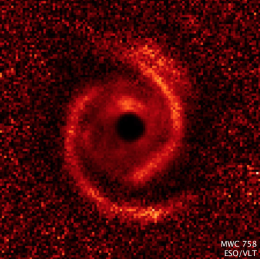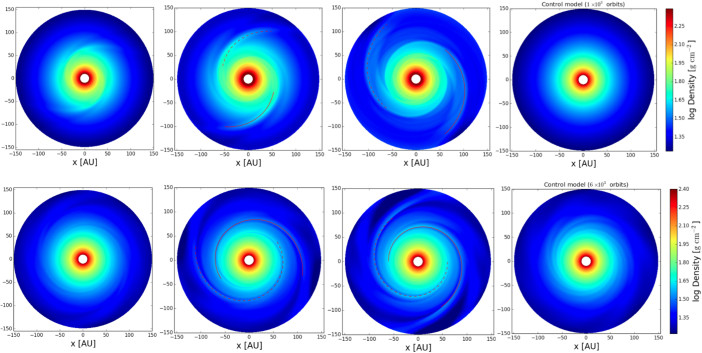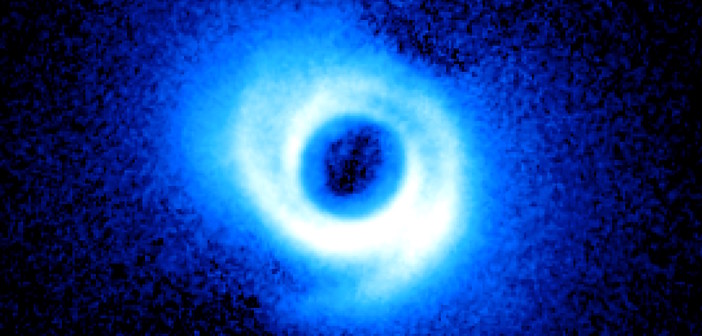What causes the large-scale spiral structures found in some protoplanetary disks? Most models assume they’re created by newly-forming planets, but a new study suggests that planets might have nothing to do with it.
Perturbations from Planets?
In some transition disks — protoplanetary disks with gaps in their inner regions — we’ve directly imaged large-scale spiral arms. Many theories currently attribute the formation of these structures to young planets: either the direct perturbations of a planet embedded in the disk cause the spirals, or they’re indirectly caused by the orbit of a planetary body outside of the arms.

Another example of spiral arms detected in a protoplanetary disk, MWC 758. [NASA/ESA/ESO/M. Benisty et al.]
Casting Shadows with Warps
In the team’s setup, they envision a protoplanetary disk that is warped: the inner region is slightly tilted relative to the outer region. As the central star casts light out over its protoplanetary disk, this disk warping would cause some regions of the disk to be shaded in a way that isn’t axially symmetric — with potentially interesting implications.
Montesinos and collaborators ran 2D hydrodynamics simulations to determine what happens to the motion of particles within the disk when they pass in and out of the shadowed regions. Since the shadowed regions are significantly colder than the illuminated disk, the pressure in these regions is much lower. Particles are therefore accelerated and decelerated as they pass through these regions, and the lack of axial symmetry causes spiral density waves to form in the disk as a result.

Initial profile for the stellar heating rate per unit area for one of the authors’ simulations. The regions shadowed as a result of the disk warp subtend 0.5 radians each (shown on the left and right sides of the disks here). [Montesinos et al. 2016]
Observations of Shadow Spirals
In the authors’ models, two shadowed regions result in the formation of two spiral arms. The arms that develop start at a pitch angle of 15°–22°, and gradually evolve to a shallower 11°–14° pitch at distances of ~65–150 AU.
The more luminous the central star, the more quickly the spiral arms form, due to the greater contrast between illuminated and shadowed disk regions: for a 0.25 solar-mass disk illuminated by a 1 solar-luminosity star, arms start to form after about 2500 orbits. If we increase the star’s brightness to 100 solar luminosities, the arms form after only 150 orbits.
Montesinos and collaborators conclude by testing whether or not such spiral structures would be observable. They use a 3D radiative transfer code to produce scattered-light predictions of what the disk would look like to direct-imaging telescopes. They find that these shadow-induced spirals should be detectable.
This first study clearly demonstrates that large-scale spiral density waves can form in protoplanetary disks without the presence of planets. The authors now plan to add more detailed physics to their models to better understand what we might observe when looking at systems that were shaped in this way.

Density evolution in two shadowed disks. Top row: disk illuminated by a 100 L⊙ star, at 150, 250, and 500 orbits (from left to right). Bottom row: disk illuminated by a 1 L⊙ star, at 2500, 3500, and 4000 orbits. The rightmost top and bottom panels show control simulations (no shadows were present on the disk) after 1000 and 6000 orbits. (A different type of spiral starts to develop in the bottom control simulation as a result of a gravitational instability, but it never extends to the edges of the disk.) [Montesinos et al. 2016]
Citation
Matías Montesinos et al 2016 ApJ 823 L8. doi:10.3847/2041-8205/823/1/L8

1 Comment
Pingback: spirals in proto planetary disks caused by shadows